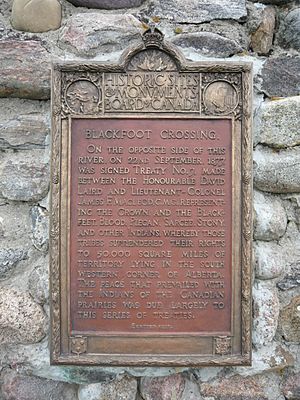Blackfoot Crossing facts for kids
Quick facts for kids Blackfoot Crossing, Treaty No. 7 Signing Site, Earthlodge Village |
|
|---|---|
 |
|
| Location | Alberta, Canada |
| Nearest city | Siksika 146 |
| Original use | First Nations site |
| Current use | Museum |
| Governing body | Siksika Nation |
| Important events | Signing of Treaty 7 |
| Designated | 1925, 1925, 1972 |
| Established | 2007 |
|---|---|
| Location | Siksika 146, Alberta, Canada |
| Type | Ethnographic museum |
Blackfoot Crossing Historical Park is a special historical place. It is located on the Siksika 146 Indian reserve in Alberta, Canada. This area is where the Bow River could be crossed easily. For a long time, it was a key spot for the Siksika people and their friends in the Blackfoot Confederacy. They used it for hunting bison and gathering.
The closest towns to Blackfoot Crossing are Cluny and Gleichen. These towns are in Wheatland County.
The Important Treaty 7 Signing Site
Blackfoot Crossing became very important in Canadian history. In 1877, Treaty 7 was signed here. This agreement was between the native nations of what is now southern Alberta and the Canadian government. The government signed on behalf of the Crown, which represents the King or Queen.
This site is also believed to be where Crowfoot, a respected chief of the Siksika, died and was buried. Another important leader, Poundmaker, a Cree chief, was also buried here. Crowfoot had adopted Poundmaker to help create peace between the Blackfoot and Cree peoples. Poundmaker's remains were later moved in 1967.
In 1925, the Canadian government recognized this traditional gathering place. They also recognized the treaty signing site. Both were declared National Historic Sites of Canada. Later, in 1972, the ancient earthlodge village nearby was also named a national historic site.
Celebrating the Treaty's History
In 1977, Prince Charles visited Blackfoot Crossing. He helped celebrate the 100th anniversary of Treaty 7. After this successful event, the Siksika council wanted to develop the site. They planned to make it a historical and tourist attraction. They started raising money and planning for this project.
In 2007, the Blackfoot Crossing Historical Park officially opened. This park includes an interpretive centre, which teaches visitors about the history. There are also monuments honoring Poundmaker, Crowfoot, and Treaty 7. Visitors can see remains of teepees and explore hiking trails. The ancient earthlodge village site is also part of the park.
The Ancient Earthlodge Village
Near Blackfoot Crossing, you can find the remains of an old earthlodge village. Experts believe people from the Upper Mississippi valley in the United States built it. This village is special because it shows a permanent settlement on the plains. The plains are usually known for nomadic hunting groups.
This earthlodge village is the only one of its kind found on the Canadian Prairies. However, similar villages are common in parts of the United States. We are not completely sure who built this village. But archaeological evidence suggests it was founded around 1740 CE. It might have been built by a group of Mandan people or their friends, the Hidatsa. This could have been before the Hidatsa and Crow people separated.


